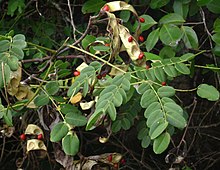Adenanthera pavonina
| Adenanthera pavonina | ||||||||||||
|---|---|---|---|---|---|---|---|---|---|---|---|---|

Adenanthera pavonina on Maui |
||||||||||||
| Systematics | ||||||||||||
|
||||||||||||
| Scientific name | ||||||||||||
| Adenanthera pavonina | ||||||||||||
| L. |
Adenanthera pavonina or Condori tree , (Indian) coral tree , (false) red sandalwood , is a tree in the legume family in the subfamily of the mimosa family from East and Southeast Asia . It was also introduced in tropical Africa and America, as well as in South Asia .
description
Adenanthera pavonina is a deciduous tree that reaches heights of growth of 10-15 meters or more. The trunk diameter is around 40–50 centimeters. The relatively smooth bark is brownish and easily cracked.
The stalked leaves are double, more or less alternating, paired or unpaired pinnate. There are up to six pairs of primary leaflets with 8–21 leaflets each. The leaves are up to 30 centimeters long, the petiole up to 5–8 centimeters. The underside lighter, egg-shaped to elliptical, glabrous and entire-margined leaflets are almost sessile and up to 2.5–3.5 inches long and up to 1.5–2.5 inches wide. At the base, the leaflet width is often uneven, the tip is rounded.
There are terminal, stalked and 12-15 cm long, racemose - panicle , cylindrical inflorescences formed. The stalked, fragrant flowers are yellowish-green to orange and five-fold with a double flower envelope. The small, overgrown cup-shaped calyx has small tips. The short overgrown petals are elongated and pointed. There are 8-10 just protruding stamens with thick filaments, the anthers have a glandular, small process. The elongated, short-stalked ovary is on top with a relatively short, sub-type stylus with a small, cephalic scar .
Dark brown and leathery, long, narrow legumes are formed. They are up to 15–22 centimeters long and up to 1.7–2 centimeters wide, between the seeds they are constricted and twist and twist as they ripen. They contain 8–12 red, more or less flattened and rounded seeds . The hard seeds are smooth and shiny and 7.5-10 millimeters in size. After ripening, the fruits get stuck for a while and the seeds stick to the sticky flesh. They are also known as coral peas or berries .
Systematics
It was first described in 1753 by Carl von Linné in Sp. Pl .: 384.
A variety is available.
- Adenanthera pavonina var. Luteosemiralis (GAFu & YKYang) XYZhu : It occurs only in China in Hainan .
use
The seeds are edible and are used raw and cooked. The young leaves are also used as vegetables. The seeds are also made into jewelry or used as toys. They were also used in the past to weigh gold, silver, and diamonds. The seeds were used in the historical Burmese measurement system "Great Ruay".
The hard and heavy, reddish wood is also known as (false) red sandalwood or coral wood . It can be used for various applications.
A red dye can be extracted from the bark . But it can also be used as a detergent.
The bark, leaves and wood are also used medicinally.
literature
- TK Lim: Edible Medicinal And Non-Medicinal Plants. Volume 2: Fruits , Springer, 2012, ISBN 978-94-007-1763-3 , pp. 507-512.
- Adenanthera pavonina in the Flora of Pakistan.
Web links
- Adenanthera pavonina at Useful Tropical Plants.
- Adenanthera pavonina at Pitchandikulam Forest Virtual Herbarium (selection in the menu on the right).
Individual evidence
- ↑ Adenanthera pavonina at KEW Science.

